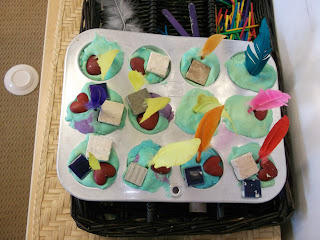Choices
In our child-centred environments, providing children with choices is something you will see everyday. Providing choices is not only beneficial for developing a child's self-esteem but also for cognitive development. A child's self-esteem grows when they successfully do things for themselves and of course it doesn't stop in childhood. I reflect on the many times that I have had an increased sense of accomplishment when tackling a new experience on my own. Making choices is also a building block of problem solving. When children are given choices, they stretch their thinking and create new and unique combinations of ideas and materials.
"Would you like to use Red or Blue?” Myriam asks. It is important to have a choice. It is especially important for Miss C to have a choice because she is two. Why is it so important for a two year old to choose ? It is not particularly important whether she selects red or blue but what is important is that she is given a real choice.Myriam knows that it is important for young children to make choices in their life so that they will feel some sense of control, which contributes to healthy personality development by building up a sense of autonomy.
 |
| Children had the choice of using the salad spinner to explore spinning and paint or to use an electronic turntable. |
This facilitator realizes that by giving children authentic, limited choices, she is building their confidence. Myriam is also eliminating much of the negativity often associated with two year olds . Children feel in control by making choices like what colours they will use or the type of spinner they will use. That growing sense of control reduces the child’s need to try to gain control in negative ways. But those choices must be authentic.
Thank you to our facilitator Myriam for sharing this invitation with children with the children visiting the Early Years Family Centre and for sharing the photos with me.
Lynda Gellner B.Ed; M.Ed








